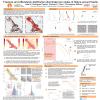Poster #141, Fault and Rupture Mechanics (FARM)
Role of permeability enhancement in the growth of injection induced aseismic ruptures
Poster Image:

Poster Presentation
2020 SCEC Annual Meeting, Poster #141, SCEC Contribution #10652 VIEW PDF
ront only under high overpressures and when background stress is very close to the residual strength(τb≈τr). This parameter regime seems too narrow to be operating across the diverse geotectonic settings where such fast seismicity migration has been observed. Here, we examine if pore-pressure induced permeability enhancement could provide an additional mechanism that allows such ruptures to outpace pore-pressure diffusion under less restrictive conditions.
We model a 1D shear rupture, pressurised by a constant overpressure (Δp) source, with damage zone permeability varying exponentially with effective normal stress and fault strength represented by linear slip weakening friction.When friction is quasi-constant, we find that the shear rupture grows self-similarly with the non-linear pore-pressure diffusion. Outpacing solutions emerge at systematically smaller pre-stress to strength ratios as permeability enhancement or over-pressure to normal stress (σ) ratios increase. For more pronounced slip-weakening, permeability enhancement permits aseismic outpacing at much lower Δp/σ values than for constant permeability fault zones. Aided by permeability enhancement, these ruptures outpace pore-pressure diffusion even when τb is substantially smaller than τr . Importantly, we find that the smallest value of τb/τr for outpacing to occur, and the extent of outpacing at a given τb/τr, are both controlled by the level of permeability enhancement and Δp/σ. Our results, therefore, provide a theoretical framework within which faster-than-diffusion ruptures can occur over a wide range of fault hydro-mechanical properties. This, in turn, provides a clue as to why the emergence of fast growing aseismic slip might not be a surprise within a variety of geotectonic settings.
SHOW MORE
We model a 1D shear rupture, pressurised by a constant overpressure (Δp) source, with damage zone permeability varying exponentially with effective normal stress and fault strength represented by linear slip weakening friction.When friction is quasi-constant, we find that the shear rupture grows self-similarly with the non-linear pore-pressure diffusion. Outpacing solutions emerge at systematically smaller pre-stress to strength ratios as permeability enhancement or over-pressure to normal stress (σ) ratios increase. For more pronounced slip-weakening, permeability enhancement permits aseismic outpacing at much lower Δp/σ values than for constant permeability fault zones. Aided by permeability enhancement, these ruptures outpace pore-pressure diffusion even when τb is substantially smaller than τr . Importantly, we find that the smallest value of τb/τr for outpacing to occur, and the extent of outpacing at a given τb/τr, are both controlled by the level of permeability enhancement and Δp/σ. Our results, therefore, provide a theoretical framework within which faster-than-diffusion ruptures can occur over a wide range of fault hydro-mechanical properties. This, in turn, provides a clue as to why the emergence of fast growing aseismic slip might not be a surprise within a variety of geotectonic settings.
SHOW MORE























































